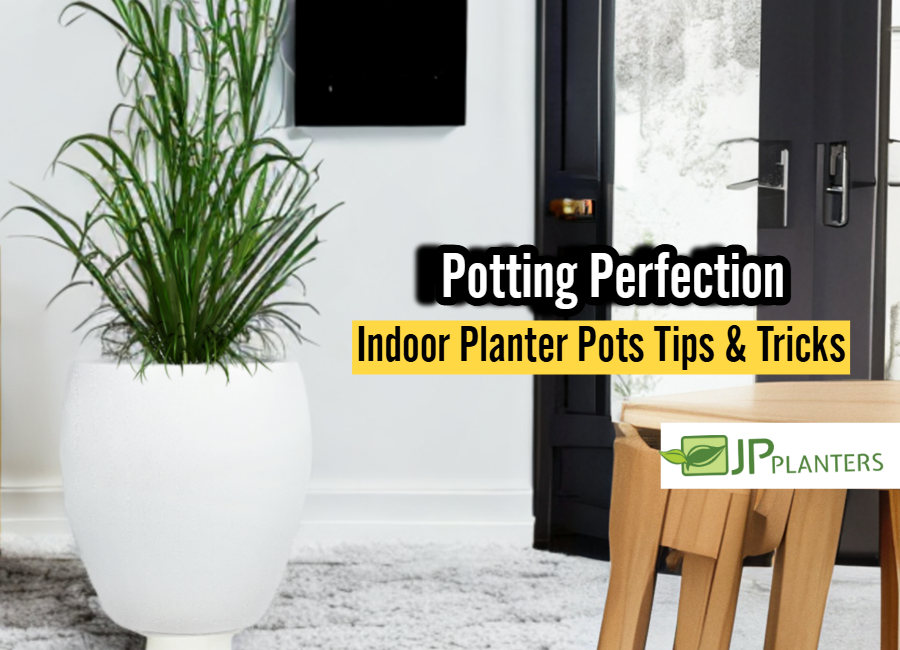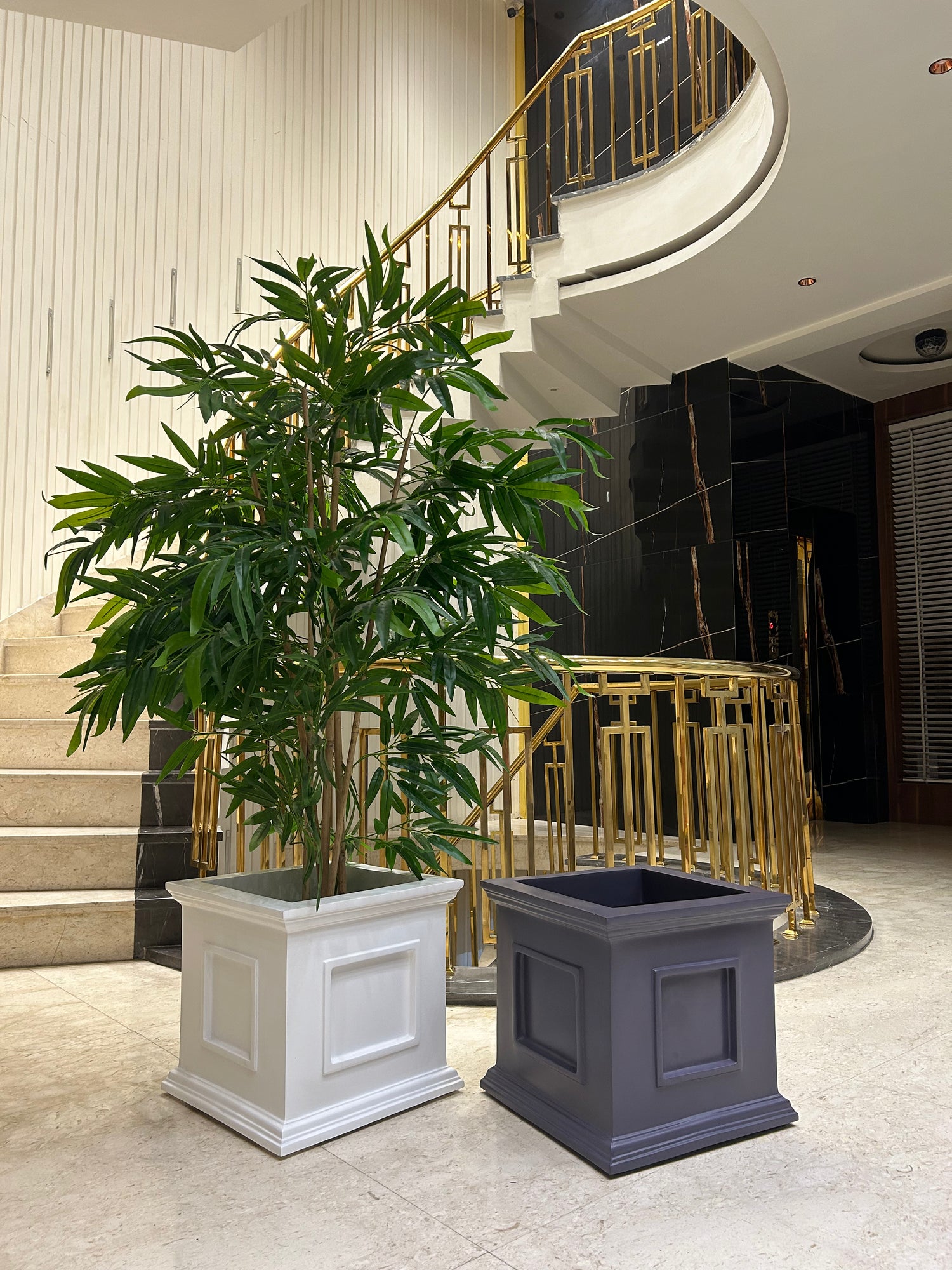
Potting Perfection: Indoor Planter Pots Tips & Tricks
Share
Indoor plants are more than just decorative accents; they bring a breath of fresh air, add life to interiors, and even purify the air. But for your leafy friends to thrive indoors, choosing the right indoor planter pots is key. The right planter doesn’t just boost the plant’s health but also enhances the aesthetics of your home. From fiber planter pots to ceramic and plastic varieties, knowing the strengths and benefits of each type can make all the difference in your plant care journey.
In this guide, we’ll walk you through everything you need to know to select, arrange, and maintain indoor planter pots. Whether you’re looking for practical tips on potting techniques, ideas for decorative pots indoor, or maintenance tricks to keep your plants and planters in top shape, we’ve got you covered.
Choosing the Right Indoor Planter Pots
Selecting the best indoor planter pots is essential for healthy plants and a beautiful home. Factors such as material, drainage, and size all influence how well your plants will grow.
1. Material Matters: Fiber Planter Pots vs. Ceramic, Plastic, and More
Each material has its pros and cons:
- Fiber Planter Pots: For eco-conscious indoor gardening enthusiasts, fiber planter pots are lightweight, durable, and often made from eco-friendly materials like fiberglass. They are sturdy yet easy to move, making them ideal for rearranging your indoor space. Fiber pots are resistant to wear and tear, making them a long-lasting option.
- Ceramic Pots: Known for their decorative appeal and sturdiness, ceramic pots can bring a classic or rustic touch to your home decor. However, they can be heavy, so they’re best suited for larger plants in permanent locations.
- Plastic Pots: Light and affordable, plastic pots are convenient for smaller plants and easy to rearrange. While they’re great for moisture retention, they may not provide as much stability for larger plants.
Choosing indoor planter pots based on material can improve not only the plant's health but also the visual appeal of your decor. Fiber planter pots, for instance, offer both durability and aesthetic versatility, blending seamlessly into modern and rustic interiors alike.
2. The Importance of Drainage
Proper drainage is crucial for indoor plants. Drainage holes prevent root rot by allowing excess water to escape. If you find a decorative pot without drainage holes, you can still use it by placing a plant in a smaller plastic pot with drainage inside the decorative pot to catch excess water. For larger plants, ensure that indoor planter pots have a built-in drainage system or consider adding stones or activated charcoal to the base layer for extra water absorption.
3. Size and Shape
Selecting the right size and shape for your indoor planter pots is vital. A pot that’s too small can lead to root-bound plants, while an overly large pot can lead to over-watering issues. As a rule of thumb, use a pot that’s at least 1–2 inches larger than the plant’s current root ball.
Creative Ideas for Decorative Pots Indoor
Adding a touch of style to your indoor planters can transform any room. Here are some creative ideas for incorporating decorative pots indoor that blend functionality with style:
1. Matching Pots with Décor Styles
- Modern Minimalist: Sleek, fiber planter pots in neutral shades work perfectly for a minimalist aesthetic. White or grey pots add an elegant touch without overpowering the room.
- Bohemian Flair: Embrace eclectic designs by mixing ceramic and fiber planter pots with earthy tones and textured patterns.
- Rustic and Industrial: Consider pots with a raw, matte finish or concrete-like texture for an industrial vibe, while wood-inspired fiber planter pots suit rustic décor.
2. Using Indoor Planters as Accents and Focal Points
Create a cozy corner by grouping different indoor planter pots of varying heights and colors. This not only makes an eye-catching focal point but also adds layers to the room. Arrange plants like pothos and philodendrons in cascading pots to create a natural, flowing effect on shelves or hanging planters.
3. Bringing Cohesiveness to Different Rooms
Use similar pot designs throughout your space to create unity. For example, if you use fiber planter pots in the living room, echo that style in the bedroom with smaller, matching pots. This gives your entire home a harmonious, cohesive look while allowing each room to maintain its unique flair.
Potting Techniques and Plant Health Tips
Proper potting technique is essential for plant health and ensures your indoor planter pots look their best. Let’s go through the basics of potting plants for indoor settings:
1. Layering for Drainage
For pots without drainage holes, start with a layer of rocks or activated charcoal to help with water absorption. Next, add potting soil formulated for indoor plants to retain moisture and nutrients.
2. Soil Choices
Indoor plants generally thrive in potting mixes that retain moisture but offer good drainage. Avoid using garden soil, as it compacts quickly and can cause waterlogging. Choose soil blends that match your plants’ specific needs—like cactus and succulent mixes for desert plants or moisture-retaining mixes for tropical plants.
3. Repotting Schedule
Repotting is essential to give your plants room to grow. A general rule is to repot every 1-2 years, or when you notice roots poking out from the drainage holes. Repot into slightly larger indoor planter pots to give roots more space.
Maintenance and Care Tips
Keeping both your indoor planter pots and plants in great shape requires some simple maintenance routines:
1. Cleaning Your Pots
Over time, pots can accumulate mineral deposits and dust. Clean fiber planter pots with a damp cloth or mild soapy water to prevent stains, and avoid harsh chemicals that may damage their surface. Ceramic and plastic pots can be soaked in a vinegar solution to remove mineral buildup. While using FRP Planters, you just need to soak a cloth in water and you can clean it easily.
2. Positioning for Optimal Light
Indoor plants thrive best in locations that meet their light needs. Place low-light plants like snake plants and pothos in dimmer areas, while high-light plants like succulents should be near windows. If natural light is limited, consider using grow lights.
3. Avoiding Common Issues
- Root Rot: Avoid over-watering by checking the soil moisture before watering. Ensure indoor planter pots have proper drainage.
- Pests: Indoor plants can attract pests like spider mites and aphids. Wipe leaves with a mild soap solution if pests are present and isolate affected plants.
Table: Comparison of Fiberglass Planters with Traditional Options
|
Feature |
Fiberglass Planters |
Clay Pots |
Plastic Pots |
|
Durability |
Excellent |
Fragile |
Moderate |
|
Weight |
Lightweight |
Heavy |
Lightweight |
|
Style Options |
Extensive |
Limited |
Limited |
|
Maintenance |
Low |
Moderate |
Low |
|
Drainage |
Can require modification |
Usually have drainage holes |
Usually have drainage holes |
|
Cost |
Slightly higher upfront |
Lower upfront |
Lower upfront |
Conclusion: Craft Your Indoor Oasis with the Right Planter Pots
Choosing the right indoor planter pots makes a world of difference in plant health and home aesthetics. From selecting the ideal material—like versatile fiber planter pots—to understanding how to maintain and arrange them creatively, indoor planters are a powerful tool in creating a stylish and tranquil home. Whether you’re drawn to sleek modern styles or boho-chic accents, experimenting with different pot designs, plants, and arrangements can elevate your space.
Ready to get started? Share your own indoor planter creations with us, and don’t forget to explore more tips and tricks on enhancing your home with plants. Sign up for our newsletter to stay updated on the latest in plant care and home decor!





